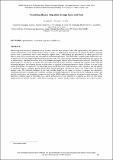| dc.contributor.author | Zambotti, Giovanni | |
| dc.contributor.author | Guan, Wendy | |
| dc.contributor.author | Gest, Justin Daniel | |
| dc.date.accessioned | 2016-04-28T15:56:47Z | |
| dc.date.issued | 2015 | |
| dc.identifier | Quick submit: 2016-02-08T15:02:50-05:00 | |
| dc.identifier.citation | Zambotti, G., W. Guan, and J. Gest. 2015. “Visualizing Human Migration Through Space and Time.” ISPRS Annals of Photogrammetry, Remote Sensing and Spatial Information Sciences II-4/W2 (July 10): 155–161. doi:10.5194/isprsannals-ii-4-w2-155-2015. | en_US |
| dc.identifier.issn | 2194-9050 | en_US |
| dc.identifier.uri | http://nrs.harvard.edu/urn-3:HUL.InstRepos:26847183 | |
| dc.description.abstract | Human migration has been an important activity in human societies since antiquity. Since 1890, approximately three percent of the world’s population has lived outside of their country of origin. As globalization intensifies in the modern era, human migration persists even as governments seek to more stringently regulate flows. Understanding this phenomenon, its causes, processes and impacts often starts from measuring and visualizing its spatiotemporal patterns. This study builds a generic online platform for users to interactively visualize human migration through space and time. This entails quickly ingesting human migration data in plain text or tabular format; matching the records with pre-established geographic features such as administrative polygons; symbolizing the migration flow by circular arcs of varying color and weight based on the flow attributes; connecting the centroids of the origin and destination polygons; and allowing the user to select either an origin or a destination feature to display all flows in or out of that feature through time. The method was first developed using ArcGIS Server for world-wide cross-country migration, and later applied to visualizing domestic migration patterns within China between provinces, and between states in the United States, all through multiple years. The technical challenges of this study include simplifying the shapes of features to enhance user interaction, rendering performance and application scalability; enabling the temporal renderers to provide time-based rendering of features and the flow among them; and developing a responsive web design (RWD) application to provide an optimal viewing experience. The platform is available online for the public to use, and the methodology is easily adoptable to visualizing any flow, not only human migration but also the flow of goods, capital, disease, ideology, etc., between multiple origins and destinations across space and time. | en_US |
| dc.description.sponsorship | Other Research Unit | en_US |
| dc.language.iso | en_US | en_US |
| dc.publisher | Copernicus GmbH | en_US |
| dc.relation.isversionof | http://www.isprs-ann-photogramm-remote-sens-spatial-inf-sci.net/II-4-W2/155/2015/isprsannals-II-4-W2-155-2015.pdf | en_US |
| dash.license | LAA | |
| dc.title | Visualizing Human Migration Through Space and Time | en_US |
| dc.type | Journal Article | en_US |
| dc.date.updated | 2016-02-08T20:02:51Z | |
| dc.description.version | Accepted Manuscript | en_US |
| dc.rights.holder | Giovanni Zambotti, Weihe Wendy Guan and Justin Gest | |
| dc.relation.journal | ISPRS Ann. Photogramm. Remote Sens. Spatial Inf. Sci. | en_US |
| dash.depositing.author | Zambotti, Giovanni | |
| dc.date.available | 2016-04-28T15:56:47Z | |
| dash.contributor.affiliated | Zambotti, Giovanni | |
| dash.contributor.affiliated | Gest, Justin Daniel | |
| dash.contributor.affiliated | Guan, Wendy | |


